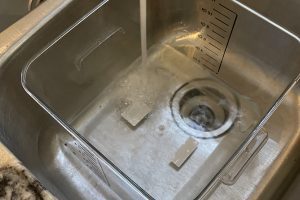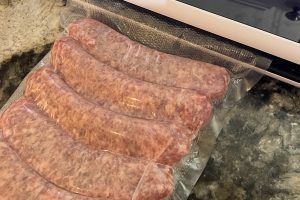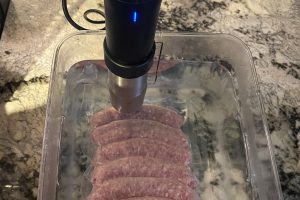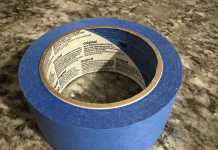I never thought I’d say this about my husband, a man who used to whip up such concoctions as “tuna chili” before we met, but he’s really good at buying me new cooking tools. He got me an Instant Pot before they were cool, and this year for Christmas I got a sous vide cooker. (Don’t worry, I also got jewelry and a puzzle of our dog.)
You may have heard of sous vide but it either sounded too specialized, too fancy, or too French for your everyday cooking. Let me disabuse you of this notion right now! The sous vide is a fantastic tool that anyone can benefit from.
(I know, I sound like an infomercial…)
There are a few tools you’ll need to make sous vide cooking a realistic option.
1. A cooker. I have this one. There are more expensive and less expensive models. I’m happy with this one.
2. A tub or bin or large pot. I have this one.
3. A vacuum sealer. This is optional. You can use ziplock bags (more on that below) and the water-displacement method, but you will be sealing your food in bags to cook it and all of the air needs to be out of the packaging or else they’ll float to the top and not cook. A vacuum sealer is ideal (especially if you, like me, have wanted one for like twenty years because of infomercials) but it is an added expense. You’ll also need vacuum sealing bags. (I’m not linking the one I have because it’s a piece of garbage.)
4. A skillet (which I assume you have already. If not, this post is already too advanced for you. Go buy a skillet!)
What does sous vide mean? I have no idea, even though my kids go to a French school. Okay, Google tells me it translates to “under a vacuum” which makes sense. But more realistically, it means you’ll be cooking your food (meat, probably) in a carefully controlled, relatively-low temperature water bath for an extended period of time.
Here is how I cook sausages in the sous vide:
Because the food is in a bag when you cook it, none of the juices escape. This means your meat does not dry out, which results in the juiciest hamburgers, sausages, and chicken you can imagine. But let me tell you where the sous vide truly shines.
Pork tenderloin.
Who doesn’t like a pork tenderloin (besides vegetarians, I mean)? But pork can be so tricky to cook without drying it out. I never truly mastered it, and because it’s so lean, there’s a fine line between getting salmonella poisoning and a dried-out, chewy slab of meat. But with the sous vide, that problem disappears. The low, slow cooking results in the juiciest, tenderest, most flavorful cut of meat you can imagine. You barely need a knife to cut it. I buy the pre-marinated kind (because I’m lazy) but you can, of course, use the flavorings of your choice.
There are plenty of great resources online for learning how to sous vide, but my cooker comes with an app (which, in theory, I could control the cooker with, but that’s unnecessary. I just use it for the guides.) So when my hunk of pork is all cozily vacuum sealed up in a bag and swimming in a tub of warm water, I set the cooker to 140 degrees and let it go for at least an hour, but no more than four. (Love the flexibility!)
You might be asking yourself, “how on earth can I eat pork cooked to 140 degrees and not end up hunched over a toilet later with food poisoning?” and the answer is, I don’t know. Science. Pasteurization. You can read more about that here. (Also apologies for mentioning a toilet in a post about cooking.)
So, once the meat is cooked, you’ll want to sear it. For a few reasons.
1. That crust on the outside of the meat is delicious!
2. It looks a lot more appetizing. Trust me, when you see that your pork tenderloin looks like a giant grub when it comes out of the packaging, you won’t mind dirtying a skillet to sear the outside.
3. It kills any potential surface bacteria.
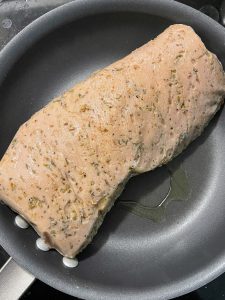
You can use a skillet or a grill for this step. I like the skillet because it’s easier to control, but my lack of skill at grilling generally is why I love the sous vide.
So, I hope I have convinced someone reading this that it’s worth spending a little bit of money to end up with juicy, tender, delicious meat on your dinner table.












